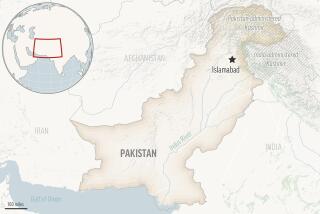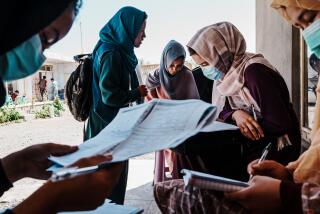20 Die in Blast as Taliban Take Fight to Afghan Skies
- Share via
KABUL, Afghanistan — The Taliban Islamic militia took the war against its enemies to the skies Thursday, scrambling MIGs to attack positions north of Kabul. In one village, 20 civilians--mostly women and children--were reported killed by a Taliban bomb.
Fierce pounding from the Talibs’ artillery, rocket batteries and Soviet-made tanks appeared to have repulsed the forces of Ahmed Shah Masoud, the ousted Afghan government’s defense chief, along two major roads north of the Afghan capital, and denied his troops the commanding heights overlooking Kabul airport.
The Talibs kept Kabul-based correspondents away from the battle line, but on the sere plain north of the airport, shepherds said the hard-line Muslim fighters had advanced overnight about a mile closer to Bagram air base, which is in the hands of Masoud’s Jamaat-i-Islami forces.
“I have seen a lot of Taliban tanks and vehicles passing north on this road,” shepherd Gul Muhammad said. He expressed an equal measure of disgust for the Taliban fighters, Masoud and Abdul Rashid Dostum, a former general who controls six northern provinces and who concluded a defensive alliance with Masoud against the Taliban on Oct. 11.
“All of them are destroying Afghanistan,” the weather-beaten shepherd said.
In the afternoon, Taliban jets screamed off the runway at Kabul airport and kept the pressure up on Masoud by bombing his positions in the hills north of the city.
In the village of Kalakon, a dozen miles from Kabul, a bomb dropped by a Taliban fighter jet reportedly killed 20 people. Many of the victims were buried when a wall was blown down by the blast.
Villagers gathered to voice their outrage at the Taliban, who have vowed to bring peace and a true Islamic order to Afghanistan by disarming rival armed groups that have been locked in civil war since 1992.
On the main highway linking Kabul with the Salang tunnel and northern Afghanistan, tank gunners and a truck-mounted rocket battery parked on a hillside at Hussein Kot joined in the pummeling of the former government’s forces.
Masoud’s troops had been trying to take control of the Khair Khay pass, 12 miles north of the capital. Witnesses on the other side of the lines said the attackers were routed late Wednesday and pursued by the Taliban beyond Kot Sati, a small village north of the pass.
“We have about 100 tanks from Kandahar now and are awaiting the order from the commander of the faithful,” Usmam Ghani, driver and gunner of a Taliban T-62 tank, said Thursday morning, referring to Taliban founder and supreme leader Mullah Muhammad Omar. “Whenever he gives the order, we will capture Bagram air base in five minutes.”
Overburdened truckloads of civilians continued to stream southward toward the capital from areas menaced by the fighting. But for the moment, Kabul itself appeared to have been spared.
Until a Kremlin-installed Communist regime fell in April 1992 to the moujahedeen, the capital--now home to an estimated 1 million people--suffered little damage. But when Masoud and other commanders took to warring among themselves, Kabul became a war zone.
Bombardments and street fighting claimed the lives of more than 25,000 people, mostly civilians, and hospitals, markets, water lines and other essential services experienced widespread destruction.
According to an estimate from the U.S.-based relief agency CARE, nearly three-quarters of Kabul’s homes and buildings were pounded into rubble.
Pakistan and the United Nations are trying to broker a cease-fire to stop the latest fighting, but the belligerents have posed conflicting preconditions.
Dr. Norbert Holl, a German diplomat serving as U.N. special envoy to Afghanistan, was supposed to meet with Taliban leaders in their southern headquarters of Kandahar on Thursday, but there was no immediate news of any results.
Jan Muhammad, 32, a teacher, is one of the many Kabulis who are pessimistic about chances for ending the bloodshed and sparing the country’s largest city more suffering. For the 15th time since Kabul became a battlefield 4 1/2 years ago, Muhammad said, he has moved himself, his wife, two children and his parents, and is now living in the rural village of Daysabz northeast of the capital.
“We don’t care if it’s the Taliban who are in charge, or whether it’s someone else,” an exasperated Muhammad, who was bicycling to the village where he has sought refuge, stopped to tell a foreign reporter. “We just want peace, security and a strong economy.”
More to Read
Sign up for Essential California
The most important California stories and recommendations in your inbox every morning.
You may occasionally receive promotional content from the Los Angeles Times.









